| Helmand (هلمند) | |
| Province | |
| Country | |
|---|---|
| Capital | Lashkar Gah |
| - coordinates | 31°00′N 64°00′E / 31.0°N 64.0°E |
| Area | 58,584 km² (22,619 sq mi) |
| Population | 1,441,769 [1] |
| Timezone | UTC+4:30 |
| Main language | Pashto, Persian |
Helmand (Pashto/Persian: هلمند) is one of the 34 provinces of Afghanistan. It is in the southwest of the country. Its capital is Lashkar Gah. The Helmand River flows through the mainly desert region, providing water for irrigation.
Helmand is the world's largest opium-producing region, responsible for 42% of the world's total production.[2][3] This is more than the whole of Burma, which is the second largest producing nation after Afghanistan. Afghan opium would account for more than 90% of the global supply.
The Helmand valley region is mentioned by name in the Avesta (Fargard 1:13) as Haetumant, one of the early centers of the Zoroastrian faith, in pre-Islamic Persian times. However, owing to the preponderance of non-Zoroastrians (Hindus and Buddhists), the Helmand and Kabul regions were also known as "White India" in those days.[4] Some Vedic scholars (eg. Kochhar 1999) also believe the Helmand valley corresponds to the Sarasvati area mentioned in the Rig Veda as the homeland for the Indo-Aryan migrations into India, ca. 1500 BC.[5]
The current governor is Mohammad Golab Mangal (since March 2008).
Much of the fighting between NATO and Taliban forces is taking place in this province and Helmand is said to be a Taliban stronghold.
Contents[hide] |
***
Afghanistan | 13.01.2011
Poppies are the one constant in Afghanistan's Helmand province
Helmand wasn't always the place where NATO and Taliban forces meet to fight for control of Afghanistan. In the 1960s, the southern Afghanistan province was known as "Little America," because it was the site of a US infrastructure development program. During much of the cold war era, American expertise and money poured into Helmand Province. A massive irrigation project helped raise towns from the desert.
"The Americans built the dam and the hospital, a hotel, a cinema and all the irrigation systems in the region," said Ali, a retired math teacher who says he no longer trusts foreigners at all. "Hundreds of Americans lived here - even the governor's wife was American."
However, this changed after the Soviet invasion in 1979. The mujahedeen fighting against the new Soviet-backed Communist regime in Kabul began receiving substantial assistance in the form of weapons and training by the US.
The omnipresent poppy
The Soviet withdrawal from Afghanistan a decade later was also accompanied by the termination of any support by the "American friend."
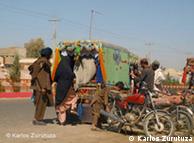 Bildunterschrift: Großansicht des Bildes mit der Bildunterschrift: Infrastructure is weak; rickshaws serve as public transport
Bildunterschrift: Großansicht des Bildes mit der Bildunterschrift: Infrastructure is weak; rickshaws serve as public transport
This time, no one stayed to help reconstruct Helmand and the rest of the country. The mujahedeen refused to accept the terms of the Geneva accords sealing the Soviet withdrawal in 1989. As a result, the civil war continued. Almost every piece of infrastructure collapsed - except for the irrigation systems.
Now, the Helmand River flows through the irrigation canals into a sea of poppies. According to the United Nations Office on Drugs and Crime, 90 percent of the opium consumed in the world comes from Afghanistan and more than half of the hectares cultivated in the country are located in Helmand. Opium provides the Taliban with a significant portion of its revenues.
"The poppy has always been here," says Ali. "The problem is that, today, there is nothing else."
Operation 'Together'
The local population feels that the last major offensive in the region, Operation Moshtarak - meaning "Together" in Dari - will have little effect on curtailing the opium-producing industry. A force of 15,000 NATO and Afghan troops was transported onto Taliban strongholds in central Helmand beginning in February 2010.
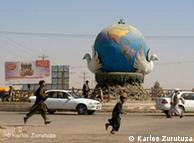 Bildunterschrift: Großansicht des Bildes mit der Bildunterschrift: The monument to peace is an ironic reminder of US development in Lashkar Gah
Bildunterschrift: Großansicht des Bildes mit der Bildunterschrift: The monument to peace is an ironic reminder of US development in Lashkar Gah
According to the commander of NATO forces in Afghanistan, US General David Petraeus, the military offensive in the Helmand province is beginning to show its effects. Petraeus told The Associated Press in an interview this week that the Taliban are losing sway in Helmand, as well as Kandahar provinces.
He said there was increasing dissension among fighting ranks of the insurgency. A surge of Afghan and foreign forces in the south is seen as key to bolstering security enough for Afghan forces to take charge. This will in turn allow US and NATO forces to reduce troops.
Taliban threat still present
The reported Taliban dissent, however, does not necessarily make people any safer in the region. Helmand's provincial governor Mohammed Gulab Mengal recently invited a delegation of local journalists to see for themselves the "excellent security improvement in the region."
Yet Asif, a local reporter, noted that a trip from the provincial capital Lashkar Gah to the poppy hub of Marjah took place in a convoy of 25 armed vehicles and accompanied by the British troops.
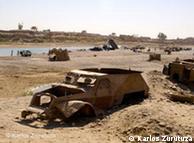 Bildunterschrift: Großansicht des Bildes mit der Bildunterschrift: Soviet debris is still found in Helmand's wastelands
Bildunterschrift: Großansicht des Bildes mit der Bildunterschrift: Soviet debris is still found in Helmand's wastelands
"That's the only way to leave Lashkar Gah by road," Asif said. In fact, very few people ever dare to venture into the road, which is accessed via a bridge over the Helmand River. There are rumors of a Taliban checkpoint only a few kilometers away.
Rahman, a young Pashtu from Nad Ali, one of the most devastated districts in the province, currently lives close to the former dance hall in Lashkar Gah.
"I live at my brother's place because I don't dare to go back to my village," Rahman said. "If you're stopped at a Taliban checkpoint, you are subject to their will. They may let you go, hit you, kill you, or simply steal your money and belongings."
Despite the ever-growing threats in the barren countryside, the provincial capital remains apparently calm. Nonetheless, there is a definite feeling of threat in the air.
"Have you seen all those cops in black ski masks? They wear them even when the temperature reaches 50 degrees but they have no other choice," 22-year-old Hamid said. "When they are identified, the Taliban threaten to kill them and their families if they do not allow their vans loaded with heroin or weapons to cross the police road controls. Some others are luckier and just get bribed."
Should NATO and Afghan troops succeed in lastingly driving away the Taliban, Helmand province could seek to reinvent itself. It has gone from "Little America" to communist Russia to a state of ongoing skirmishes between NATO forces looking eagerly for a way to pull out of the region, and Taliban looking for a stronger foothold there. The only constant throughout the province's long history, it seems, is the popularity of its main crop: the poppy.
Author: Karlos Zurutuza (jen)
Editor: Sabina Casagrande

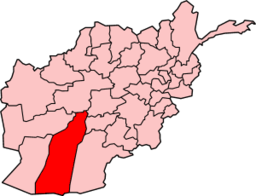
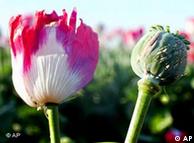
沒有留言:
張貼留言